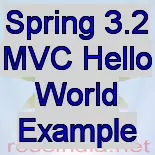Spring 3.2 MVC Hello World Example
In this section, you will learn about Hello World example in Spring 3.2.
Spring 3.2 is a open source application framework based on Java platform.
Spring MVC is the Spring's web framework.
Given below a basic tutorial for displaying a "hello world" message in Spring
3.2. This will help you understanding the basic configuration for Spring MVC :
The project structure of this example is given below :

The list of the jar file used in this example is given below :
- commons-logging-1.1.1.jar
- jstl-1.2.jar
- spring-beans-3.2.0.RELEASE.jar
- spring-context-3.2.0.RELEASE.jar
- spring-core-3.2.0.RELEASE.jar
- spring-expression-3.2.0.RELEASE.jar
- spring-web-3.2.0.RELEASE.jar
- spring-webmvc-3.2.0.RELEASE.jar
First you need to configure web.xml as follows :
web.xml( Spring3.2HelloWorld/WebContent/WEB-INF/web.xml )
<?xml version="1.0" encoding="UTF-8"?> <web-app xmlns="http://java.sun.com/xml/ns/javaee" xmlns:xsi="http://www.w3.org/2001/XMLSchema-instance" xsi:schemaLocation="http://java.sun.com/xml/ns/javaee http://java.sun.com/xml/ns/javaee/web-app_3_0.xsd" version="3.0"> <display-name>Spring3.2HelloWorld</display-name> <welcome-file-list> <welcome-file>index.jsp</welcome-file> </welcome-file-list> <servlet> <servlet-name>dispatcher</servlet-name> <servlet-class>org.springframework.web.servlet.DispatcherServlet</servlet-class> <load-on-startup>1</load-on-startup> </servlet> <servlet-mapping> <servlet-name>dispatcher</servlet-name> <url-pattern>*.html</url-pattern> </servlet-mapping> </web-app>
As you can see the welcome file is "index.jsp", it means it will be the first
page, which will show to you. The DispatcherServlet is configured
with <servlet-name> "dispatcher". You can choose any
name for <servlet-name>. Once it will initialize, it will
search for a configuration file <servlet-name>-servlet.xml
or dispatcher-servlet.xml in WEB-INF folder of web application. This
fill is necessary to configure your MVC application. The
dispatcher-servlet.xml used in this example is given below :
dispatcher-servlet.xml( Spring3.2HelloWorld/WebContent/WEB-INF/dispatcher-servlet.xml )
<?xml version="1.0" encoding="UTF-8"?> <beans xmlns="http://www.springframework.org/schema/beans" xmlns:xsi="http://www.w3.org/2001/XMLSchema-instance" xmlns:p="http://www.springframework.org/schema/p" xmlns:context="http://www.springframework.org/schema/context" xsi:schemaLocation=" http://www.springframework.org/schema/beans http://www.springframework.org/schema/beans/spring-beans.xsd http://www.springframework.org/schema/context http://www.springframework.org/schema/context/spring-context.xsd"> <context:component-scan base-package="net.roseindia.spring3point2.controller" /> <bean id="viewResolver" class="org.springframework.web.servlet.view.UrlBasedViewResolver"> <property name="viewClass" value="org.springframework.web.servlet.view.JstlView" /> <property name="prefix" value="/WEB-INF/jsp/" /> <property name="suffix" value=".jsp" /> </bean> </beans>
The <context:component-scan> tag scans the classpath for annotated components that will be auto-registered as Spring beans. UrlBasedViewResolver resolver is configured to resolve the views.
The first page that will appear to you is "index.jsp", its code is given below :
<%@ page language="java" contentType="text/html; charset=ISO-8859-1" pageEncoding="ISO-8859-1"%> <!DOCTYPE html PUBLIC "-//W3C//DTD HTML 4.01 Transitional//EN" "http://www.w3.org/TR/html4/loose.dtd"> <html> <head> <meta http-equiv="Content-Type" content="text/html; charset=ISO-8859-1"> <title>Index or Home Page</title> </head> <body> <a href="welcome/hello.html"><i>Click here to print message</i></a> </body> </html>
All the request having URL pattern "*.html" is handled by the controller HelloWorldController.java, the code of this controller is given below :
HelloWorldController.java(Spring3.2HelloWorld/src/net/roseindia/spring3point2/controller/HelloWorldController.java)
package net.roseindia.spring3point2.controller;
import org.springframework.stereotype.Controller;
import org.springframework.ui.ModelMap;
import org.springframework.web.bind.annotation.RequestMapping;
@Controller
@RequestMapping("/welcome")
public class HelloWorldController {
@RequestMapping("/hello.html")
public String sayHello(ModelMap model) {
model.addAttribute("message", "Spring 3.2 MVC Hello World");
return "hello";
}
}
In the above controller, you can see that the request through URL "/welcome/hello.html" is handled by the method sayHello(). This method will return string "hello" which is resolved by the view resolver configured in dispatcher-servlet.xml and it will look for hello.jsp file in "/WEB-INF/jsp/hello.jsp".
The code for the hello.jsp is given below :
hello.jsp(Spring3.2HelloWorld/WebContent/WEB-INF/jsp/hello.jsp)
<%@ page language="java" contentType="text/html; charset=ISO-8859-1"
pageEncoding="ISO-8859-1"%>
<!DOCTYPE html PUBLIC "-//W3C//DTD HTML 4.01 Transitional//EN" "http://www.w3.org/TR/html4/loose.dtd">
<html>
<head>
<meta http-equiv="Content-Type" content="text/html; charset=ISO-8859-1">
<title>Spring 3.2 Hello World</title>
</head>
<body>
<h2><i>${message}</i></h2>
</body>
</html>
OUTPUT
When you execute your application, you will get the following page first :

When you click on the hyperlink, you will get the following page with message :

You can download the source code without jar file using below link.
